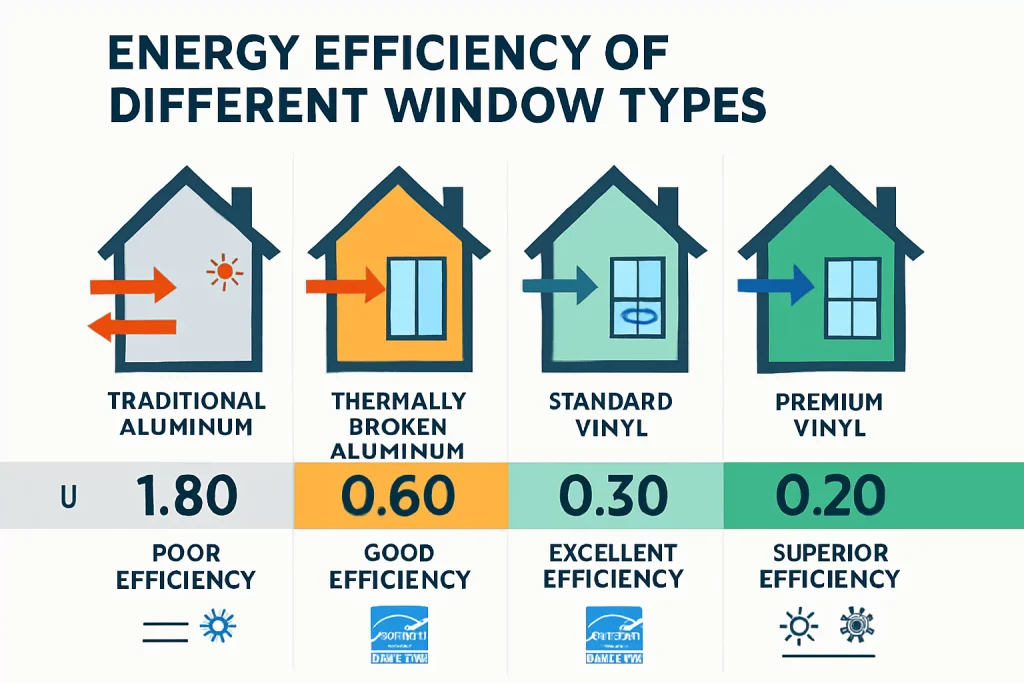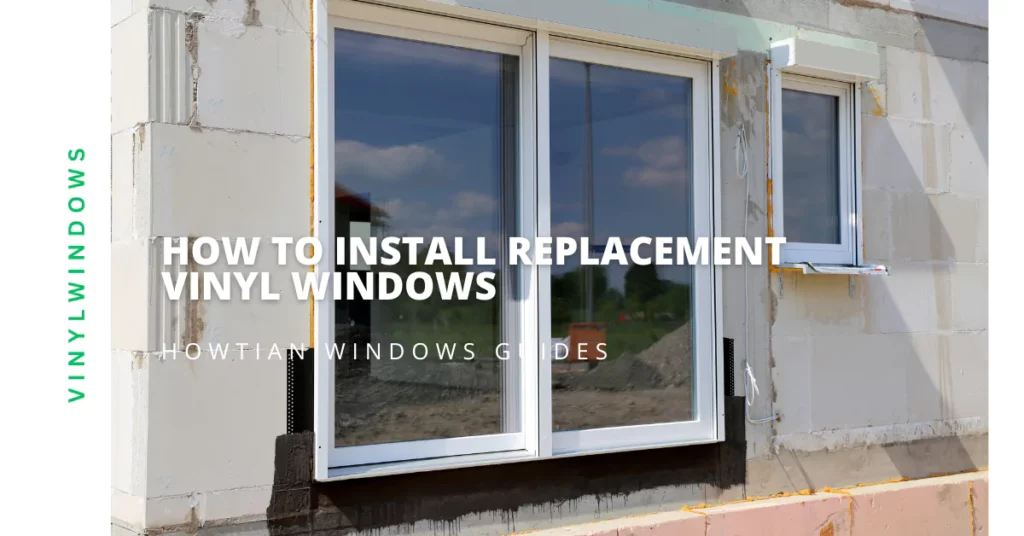Your window choice impacts everything from your monthly energy bills to your home’s architectural style and long-term maintenance requirements. When it comes to replacement windows, two materials dominate today’s market: aluminum and vinyl. Each offers distinct advantages that make them suited for different homes, climates, and budgets.
On one hand, aluminum windows represent the strong, sleek, modern choice—offering exceptional durability, thin profiles that maximize glass area, and a contemporary aesthetic that complements today’s architectural trends. On the other hand, vinyl windows have earned their reputation as the insulating, budget-friendly champion, delivering excellent energy efficiency, low maintenance, and outstanding value for most homeowners.
This comprehensive guide provides a definitive, head-to-head comparison to help you choose the right material for your specific climate, architectural style, and budget constraints. By the end, you’ll have the knowledge needed to make an informed decision that will serve your home for decades to come.
At a Glance: The Ultimate Aluminum vs. Vinyl Comparison Chart
| Feature | Aluminum Windows | Vinyl Windows |
|---|---|---|
| Aesthetics | Thin frames, sleek modern look, durable finish | Thicker frames, clean look, limited colors |
| Strength & Durability | Exceptional (resists bending/warping) | Very Good |
| Energy Efficiency | Poor (without thermal break); Good (with) | Excellent |
| Initial Cost | Moderate (often slightly higher than vinyl) | Low |
| Maintenance | Very Low | Very Low |
| Lifespan | 30-50 years | 20-30 years |
| Best Climate | Hot, Moderate, Coastal/Storm-Prone | Cold, Mixed |
Energy Efficiency: The Most Critical Difference

Vinyl: The Natural Insulator
Vinyl windows are naturally energy efficient because PVC (polyvinyl chloride) is inherently a poor conductor of heat. This fundamental material property means that vinyl window frames resist heat transfer, helping to maintain consistent indoor temperatures regardless of outdoor conditions. The multi-chambered design of modern vinyl frames creates additional air pockets that further enhance insulation performance.
This natural insulation property is one of the key reasons why vinyl windows are considered a good investment for energy-conscious homeowners. The material itself acts as a thermal barrier, reducing heat loss in winter and heat gain in summer.
Aluminum: The Conductor
Aluminum, while offering exceptional strength and durability, readily transfers heat due to its metallic composition. This high thermal conductivity makes non-insulated aluminum frames very inefficient from an energy standpoint. Traditional aluminum windows can create significant thermal bridging, where heat flows directly through the frame material, leading to higher energy bills and uncomfortable temperature variations near windows.
However, this energy efficiency challenge has led to significant innovation in aluminum window technology.
The “Thermal Break” Explained in Simple Terms
What It Is: A thermal break consists of a reinforced polyamide or plastic strip that physically separates the interior and exterior aluminum frame pieces. This barrier is typically 14-34mm wide and is mechanically joined to both the interior and exterior aluminum components.
How It Works: This plastic strip acts as an insulating barrier, stopping heat from flowing through the conductive aluminum frame. The thermal break essentially creates two separate aluminum frames—one interior and one exterior—connected only by the non-conductive barrier material.
The Result: “Thermally broken” aluminum windows offer good, modern energy performance that can compete with many standard vinyl windows. While high-end insulated vinyl often still maintains an edge in pure thermal performance, thermally broken aluminum windows can achieve respectable U-values and energy ratings suitable for most climates.
Strength & Durability: Where Aluminum Shines
Aluminum: Lightweight Power
Despite being significantly lighter than steel, aluminum offers incredible strength and structural rigidity. This strength-to-weight ratio is what makes aluminum ideal for aerospace applications, and it provides similar benefits in window manufacturing. Aluminum frames resist bending, warping, and structural deformation even under significant stress.
The Practical Benefits
This exceptional strength translates into several practical advantages for homeowners:
Larger Glass Areas: Aluminum’s strength allows for much larger panes of glass with thinner, less obtrusive frames. This is particularly beneficial for panoramic windows, large patio doors, and modern architectural designs that emphasize unobstructed views.
Storm Resistance: Aluminum windows excel in areas prone to severe weather. The material’s resistance to bending and warping makes it ideal for coastal regions where hurricane-force winds and impact debris are concerns.
Structural Integrity: Large window openings that might require additional support with other materials can often be accommodated with aluminum frames alone, reducing installation complexity and costs.
Vinyl: Reliable and Robust
High-quality vinyl offers excellent durability for most residential applications. Modern vinyl formulations resist UV degradation, temperature fluctuations, and moisture exposure. However, vinyl is less rigid than aluminum, which can limit its use in very large window applications or areas with extreme weather conditions.
Understanding how long vinyl windows last is important when considering durability, as quality vinyl windows typically provide 20-30 years of reliable service with minimal maintenance.
Aesthetics & Appearance: Modern Minimalist vs. Practical Standard
The Architectural Advantage of Aluminum
Thin Sightlines: Aluminum’s superior strength means frames can be engineered to be remarkably narrow—often 50% thinner than comparable vinyl frames. This creates larger glass areas and provides virtually unobstructed views, making rooms feel more spacious and connected to the outdoors.
Modern Style: Aluminum windows are perfect for contemporary, industrial, and minimalist home designs. The clean lines and narrow profiles complement modern architectural trends that emphasize simplicity, light, and connection between indoor and outdoor spaces.
Durable Finishes: Powder-coated aluminum finishes are extremely durable and available in a wide range of colors, including custom options. These finishes resist fading, chalking, and weathering much better than painted surfaces, maintaining their appearance for decades.
Vinyl: The Clean, All-Purpose Look
Traditional Appearance: Vinyl windows’ thicker frames provide a more traditional window appearance that works well with various architectural styles, from colonial to ranch homes. The proportions are familiar and tend to blend seamlessly with existing home designs.
Integrated Color: With vinyl windows, color is integrated throughout the material rather than applied as a surface coating. This means minor scratches and dings don’t reveal a different color underneath, helping maintain a clean appearance over time.
Limited but Practical Palette: While vinyl’s color options are more limited than aluminum’s, the available colors are chosen for their broad appeal and compatibility with most home exterior colors.
Cost & Lifespan: The Value Equation

Initial Cost
Vinyl window costs are typically the most affordable in the replacement window market. Standard vinyl windows often cost 20-40% less than thermally broken aluminum windows, making them accessible to a broader range of budgets.
Thermally broken aluminum windows command a premium due to their more complex manufacturing process and higher material costs. However, this cost difference has narrowed in recent years as aluminum window technology has become more widespread.
Lifespan Expectations
Aluminum’s inherent durability and resistance to degradation gives it a longer expected lifespan:
- Aluminum windows: 30-50 years with proper maintenance
- Vinyl windows: 20-30 years under normal conditions
Long-Term Value Analysis
While aluminum windows may cost more initially, their extended lifespan can offset the higher upfront investment. When calculated on a cost-per-year basis, aluminum windows often provide competitive value, especially in harsh climates where their durability advantages are most pronounced.
Additionally, aluminum windows’ timeless aesthetic and structural integrity may contribute to better long-term home value retention, though this varies by market and architectural style.
Maintenance & Upkeep: An Easy Win for Both
Both aluminum and vinyl windows offer excellent low-maintenance characteristics:
Shared Benefits:
- No painting or staining required
- Resistant to rot, corrosion, and pest damage
- Easy cleaning with standard household cleaners
- Minimal hardware maintenance
Aluminum Advantages:
- Powder-coated finishes are virtually maintenance-free
- No risk of color fading or chalking
- Durable enough for high-pressure washing
Vinyl Advantages:
- Simple cleaning routines keep them looking new
- Surface scratches are less visible due to integrated color
- No risk of corrosion in coastal environments
The Right Window for Your Climate and Style

Choose Aluminum If:
Climate Considerations:
- You live in hot, sunny climates where UV resistance is crucial
- Your area experiences severe weather, including hurricanes or high winds
- Coastal locations where salt air might affect other materials
Design Priorities:
- You desire a modern, minimalist aesthetic with maximum glass area
- Your home features contemporary or industrial architecture
- You need very large windows or expansive patio door systems
- Strength and longevity are your top priorities
Specific Applications:
- Floor-to-ceiling windows
- Large picture windows
- Commercial-style residential applications
- Custom color requirements
Choose Vinyl If:
Climate Considerations:
- You live in cold climates where maximum insulation is critical
- Your area experiences moderate weather without extreme temperature swings
- Energy efficiency is your primary concern
Budget and Value Priorities:
- Budget is your primary decision-driver
- You want proven, reliable performance without premium costs
- You prefer the traditional window appearance
- Low maintenance is essential
Home Style Compatibility:
- Traditional architectural styles (colonial, ranch, craftsman)
- Homes where window replacement is part of broader energy efficiency improvements
- Applications where vinyl’s energy efficiency benefits provide the most value
Make Your Decision with Confidence
Understanding these key differences between aluminum and vinyl windows is essential for making the right choice for your home. Both materials offer excellent performance in their ideal applications, and your decision should align with your specific climate, architectural style, and long-term goals.
For personalized guidance on which window material is perfect for your specific situation, consider factors like your local climate patterns, home architecture, budget constraints, and personal aesthetic preferences. Many homeowners find that consulting with window professionals helps them weigh these factors effectively and choose the solution that will serve them best for decades to come.
Whether you choose the modern strength of aluminum or the all-around value of vinyl, both materials represent significant improvements over older window technologies and will enhance your home’s comfort, efficiency, and appearance for years to come.
Ready to explore your options further? Learn more about what makes vinyl windows a good investment or discover how long quality vinyl windows can last in your specific climate.






